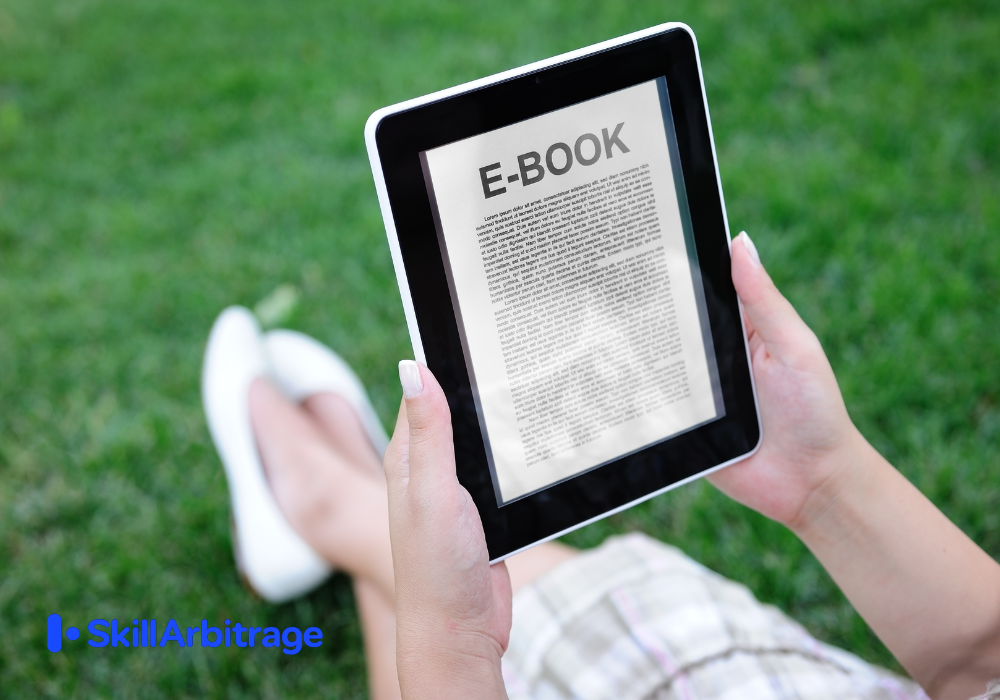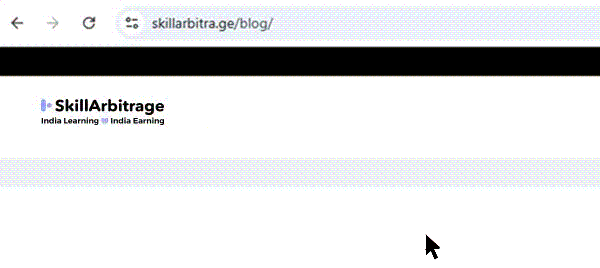This blog unlocks a powerful, step-by-step framework to help you write a high-quality eBook, faster and smarter with AI. Whether you’re a content writer, ghostwriter, marketer, or small business owner, you’ll discover how to go from idea to polished eBook in just weeks, not months.
Table of Contents
Introduction
“I wish I could write a book!” Countless writers have said that with a sigh over and over again. And why writers, most creative people, have a book brewing somewhere, and again most of them never get to write them.
But here’s the thing: books are no longer witty stories and scandalous memoirs. They are instead marvelous marketing collateral, desperately sought out by brands.
If I had a rupee every time I heard a client lament the absence of a lead magnet in the form of an e-book or a professional talking about his frustrations of not being able to give enough time to belt out his own e-book, which would establish his authority beyond doubt…I swear I would be a billionaire by now.
But an eBook has benefits even beyond lead generation. It’s a strategic asset that:
- Positions you as a credible authority
- Provides content for months of social media and blog posts
- Creates speaking and media opportunities
- Establishes frameworks that become signature methodologies
But why do most eBook dreams die an untimely death?
Let’s talk about a familiar scenario.
Remember that brilliant eBook idea you had six months ago?
The one that was going to establish your expertise, generate qualified leads, and position you as the go-to authority in your field?
Yeah, it’s probably still sitting in your “someday” folder, buried under a mountain of good intentions and the crushing reality of how long it actually takes to write 50 pages of quality content.
But what keeps people from writing the book of their dreams?
Here’s what typically happens: Week one, you’re fired up, cranking out research and outlining chapters.
Week three, you’re staring at a half-finished draft, wondering why every sentence sounds like it was written by a committee of robots.
Week six, you’ve convinced yourself that maybe a blog post series would be just as effective
Spoiler alert: it won’t be.
But what if I told you there’s a way to write that 50-page eBook in weeks, not months, without sacrificing your unique voice or credibility?
Sounds incredible?
Enter the world of AI-assisted eBook creation, not the kind that spits out generic, soulless content that screams “written by a machine,” but a collaborative approach that amplifies your expertise while handling the heavy lifting.
The eBook landscape has exploded in recent years, and for good reason.
They are not just lead magnets anymore. They are authority-building powerhouses that can transform how your audience perceives your expertise.
In an era where Google’s E-E-A-T (Experience, Expertise, Authoritativeness, Trustworthiness) guidelines increasingly favor demonstrated knowledge and credible content, a well-crafted eBook isn’t just nice to have; it is essential.
So, what’s the holdup?
The challenge isn’t recognizing the value of eBooks; it’s actually creating them without burning out or producing something that reads like an assembly manual.
But here’s the thing: the biggest obstacle isn’t lack of knowledge or even time. It’s the traditional writing process itself.
The problem isn’t your expertise or commitment. It’s that traditional eBook creation is a brutal endurance test that exhausts your creativity before you can showcase your best thinking.
In this blog, I will tell you about my personal experiences with AI tools in eBook writing and how you can achieve in weeks what takes most authors years or months to write.
The eBook opportunity everyone’s missing, but you should not
Despite the explosion of video content and interactive media, eBooks remain the heavyweight champions of content marketing.
They generate a lot more qualified leads than shorter content pieces, and here’s why that matters: someone willing to trade their email for a 50-page resource is demonstrating serious intent.
Each piece of derivative content reinforces your expertise while pointing back to the original authority piece.
Consider this example: A consulting firm struggling to differentiate in a crowded market created “The Digital Transformation Executive’s Playbook” – a 65-page deep dive into managing technology change.
Within four months, it had generated over 3,000 qualified leads and transformed their market positioning.
Sales conversations became easier because prospects arrived pre-educated. Speaking opportunities multiplied. Industry publications started seeking their commentary.
And this is what you can now do easily because now you can navigate the common roadblocks easily with AI tools.
Traditional eBook creation nightmare
Let’s be honest about why most eBook projects fail. Understanding these challenges is crucial because AI isn’t magic – it’s a strategic tool that addresses specific pain points.
1. Research overwhelm
Quality eBooks require synthesizing dozens of sources, organizing insights into coherent themes, and ensuring accuracy.
I have watched writers spend three weeks just on research, only to realize they’ve wandered down irrelevant rabbit holes.
2. The dreaded tone drift
You start with energy and clarity, but by chapter three, your voice has mysteriously transformed into corporate speak.
Chapter five sounds like a different author entirely. Maintaining consistent personality across 15,000+ words is genuinely challenging.
3. Citation chaos
You know you read something relevant, but was it the Harvard Business Review piece or the McKinsey report? Proper attribution is crucial for credibility, but managing citations manually is tedious and prone to errors.
4. Creative fatigue
The mental energy required for sustained long-form writing is enormous.
Most people can produce 1,000-2,000 words of quality content before their creativity starts declining.
An eBook demands maintaining that standard across 20,000+ words.
5. The perfectionism trap
Writers get stuck endlessly revising chapter one, convinced they need perfection before moving forward.
Meanwhile, momentum dies, enthusiasm wanes, and the project stalls indefinitely.
The time investment is prohibitive for most professionals: 80-120 hours of focused work spread across 2-4 months.
For many experts, the opportunity cost makes eBook creation financially impractical, even when they recognize the long-term value.
How AI transforms the entire process
Do you know what the breakthrough insight was that changed everything for me?
Realizing that AI isn’t replacing human creativity, it’s removing the friction that prevents creativity from flowing effectively.
Think of AI as your research assistant, writing partner, and editorial team combined. The new AI tools can assist you at every stage of the book-writing process.
1. Strategic research
Tool: Claude Pro ($20/month) or ChatGPT Plus ($20/month)
Instead of spending days reading and note-taking, you can feed AI your source materials and get structured summaries with proper attribution.
Claude excels at handling longer documents (up to 200,000 tokens), while ChatGPT Plus allows file uploads for PDFs and documents.
My research workflow uses targeted prompts like: “Analyze this source for an eBook about [topic]. Extract: 1) Main argument, 2) Three supporting points with evidence, 3) Relevant statistics, 4) Quotable insights, 5) How this supports my specific angle on [topic]. Include full citation details.”
Pro tip: Use Claude’s “Projects” feature to maintain context across your entire research phase, or create a custom GPT in ChatGPT specifically for your eBook project.
This approach ensures every piece of research directly serves your eBook’s objectives rather than adding to information overload.
2. Drafting in your own voice
Tool: Claude Pro for conversational tone, ChatGPT Plus for structured content
The secret isn’t asking AI to write your eBook, it’s collaborating strategically. Claude tends to produce more natural, conversational writing that feels less robotic, while ChatGPT Plus excels at structured, organized content.
Here’s my advanced drafting approach:
Follow these simple layering techniques to get the most effective results.
Layer 1: Structure generation
Use ChatGPT Plus with prompts like: “Create a detailed outline for a 2,000-word chapter on [topic]. Include: opening hook, 3-4 main sections, supporting examples for each section, and smooth transitions.”
Layer 2: Content development
Switch to Claude Pro for actual writing: “Write a 400-word section on [specific topic] in a conversational tone. Requirements: Mix short and long sentences, start with a relatable scenario, include one specific example, avoid corporate jargon.”
Layer 3: Voice refinement
Use either tool to polish, but Claude Pro tends to maintain personality better during revisions.
Layer 4. Maintaining voice parity
Tool: Custom GPT (ChatGPT Plus) or Claude Projects
Generic AI output feels robotic because most people use generic prompts. Instead, create detailed “voice profiles” using either:
- Custom GPT: Upload samples of your best writing and train it specifically for your voice
- Claude Projects: Create a project with your voice guidelines and reference examples
Reference this profile in every drafting prompt: “Write this section consistent with this voice sample: [paste example]. Maintain the same conversational energy and specificity level.”
The transformation in action
Compare the two samples given below, one before AI collaboration and one after to understand the difference that AI can make to your writing.
Before AI collaboration (Robotic)
“This section will provide comprehensive coverage of email marketing strategies. Email marketing represents an effective tool for business communication. Organizations should consider several best practices when implementing email marketing campaigns.”
After Strategic Collaboration (Natural)
“Let’s talk about email marketing – but not the kind that makes people immediately hunt for the unsubscribe button. You know the type: those generic blasts that feel like they were written by robots who’ve never actually sent a personal email in their lives. Real email marketing starts with one simple question: If this message appeared in your own inbox, would you actually read it?”
AI not only makes your writing seem natural, with the right prompts, but it also makes it more impactful.
The framework for writing: what AI tools and prompts to use
1. Research phase
Tools: Claude Pro + Zotero (free citation management)
- Create organized folders in Zotero for different source types
- Use Claude Pro’s document analysis for PDF research papers
- Specific prompt: “Analyze this research paper for my eBook on [topic]. Create: 1) Executive summary, 2) Key statistics with page numbers, 3) Relevant quotes with citations, 4) How this supports my thesis that [your angle]”
- Build citation management into your workflow from day one using Zotero
- Plan research needs during the outline phase, not during writing
2. Writing phase
Tools: ChatGPT Plus for structure, Claude Pro for content
- Strategic outline: Use ChatGPT Plus: “Create a comprehensive eBook outline for [topic] targeting [audience]. Include: chapter titles, 3-4 main points per chapter, supporting evidence needed, estimated word count per section”
- Content generation: Switch to Claude Pro for natural writing: “Write section 2.3 about [specific topic] for business professionals. Tone: consultative expert sharing insider knowledge. Length: 600 words. Include: opening question, main teaching point, real-world example, transition to next section”
- Consistency maintenance: Use Claude Projects to maintain voice and terminology across chapters
3. Quality control
Tools: Grammarly Premium ($12/month) + Claude Pro
- Upload sections to Grammarly for technical editing
- Use Claude Pro for fact-checking: “Review this section for: 1) Unsupported claims that need citations, 2) Statistics that should be verified, 3) Statements that might be controversial, 4) Technical accuracy of explanations”
- Verify all AI-generated statistics using original sources
- Test formatting early using your chosen design tool
4. Citation management
Tools: Zotero + Claude Pro
- Use Zotero to organize all sources during research
- Claude Pro prompt: “Generate APA citations for these sources: [list sources]. Also indicate which type of credibility each source provides (academic authority, industry data, expert opinion, case study evidence)”
- Create citation placeholders during writing: [STAT: email marketing ROI] to maintain flow
- Use Claude Pro to suggest citation needs: “Review this section and identify claims that would benefit from supporting citations”
5. Design and formatting
Tools: Canva Pro ($15/month) or Adobe InDesign
- For most creators:
Canva Pro offers professional eBook templates with:
- Consistent typography and branding
- Built-in table of contents formatting
- Professional cover design options
- Export options for both PDF and ePub
- For advanced users: Adobe InDesign provides complete control but requires design knowledge
6. Promotional content creation
Tools: Claude Pro for social media, ChatGPT Plus for email sequences
- Social media content: Claude Pro excels at platform-specific content: “From chapter 3 of my eBook, create 5 LinkedIn posts that provide value while encouraging download. Each post should: start with a business problem, share one insight, include a statistic, and a soft CTA for the eBook.”
- Email sequences: ChatGPT Plus is better for structured email campaigns: “Create a 5-email nurture sequence for eBook downloaders. Email 1: Welcome + implementation guide, Email 2: Case study expansion, Email 3: Bonus template, Email 4: Community invitation, Email 5: Consultation offer”
Tool comparison summary
Here is a summary of all the tools I talked about in the previous secion.
The strategic workflow
Follow this workflow to get your book done and dusted in weeks.
This systematic approach transforms a 3-4 month traditional process into a 6-8 week strategic collaboration.
Conclusion
The AI tools will continue evolving, but the fundamental principles remain constant: strategic collaboration, systematic quality control, and authentic voice development. Master these with current tools, and you’ll easily adapt to whatever emerges next.
Your expertise deserves a wider audience. AI can help you reach them without sacrificing authenticity or burning out in the process.
The difference between experts who successfully scale their influence and those who remain well-kept secrets often comes down to their willingness to systematically share their knowledge.
That eBook idea you’ve been carrying around? It’s time to stop treating it like a someday project and start treating it like the strategic asset it could become. Your insights are valuable.
Your audience is waiting. And now you have the tools to connect them efficiently.
The only question left is: what will you create first?
FAQs
1. Can AI really write an eBook that sounds like me?
Answer: Absolutely! AI tools like Claude or ChatGPT don’t replace your voice—they amplify it. By providing the AI with samples of your writing and specific prompts (e.g., “Write in a conversational tone like [your sample]”), you can ensure the eBook reflects your unique style. Think of AI as a co-writer that handles repetitive tasks while you shape the tone and message.
2. Do I need technical skills to use AI tools for eBook writing?
Answer: No technical expertise is required. Tools like ChatGPT and Claude are user-friendly—just type your instructions like you’re asking a question. Start with simple prompts, such as “Create an outline for an eBook on [your topic],” and the AI will guide you. Free tutorials on platforms like YouTube can also help you get started quickly.
3. How much time can AI really save when writing an eBook?
Answer: AI can cut the traditional 3–4 month eBook creation process to 6–8 weeks or less. For example, AI can summarize research in hours instead of weeks, generate chapter drafts in days, and handle citations automatically. This lets you focus on refining your ideas, potentially saving 50–70 hours of work.
4. Will my eBook seem less credible if I use AI?
Answer: Not if you use AI strategically. AI helps with research, drafting, and editing, but you provide the expertise and final polish. By fact-checking AI-generated content and adding your unique insights, your eBook will maintain credibility. Properly cited sources and a professional tone further enhance trust, aligning with Google’s E-E-A-T guidelines.
5. What’s the first step to start writing my eBook with AI?
Answer: Begin by defining your eBook’s topic and audience, then sign up for a free trial of Claude or ChatGPT. Use a prompt like: “Create a detailed outline for a 10,000-word eBook on [your topic] for [your audience].” This will give you a clear structure to start researching and drafting.







 Allow notifications
Allow notifications
